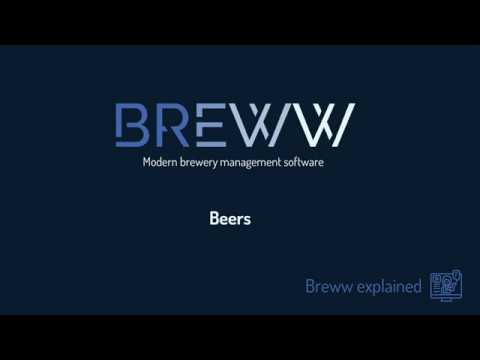This section is where you manage your beer production, recipes and vessels. This also includes racking, 3rd party smallpack packagers and hop contracts.
Beers
To take full advantage of Breww’s powerful production section, you’ll need to create your beers first. Recipes can be attached to beer after the beer has been created.
Recipes
Breww’s recipes module is extremely powerful. Recipes can be assigned to beers or left unassigned to be used as a basis for future recipes. Recipes help you manage your ingredient requirements, costs, and they form the basis of our brew day sheets.
Recipes are made from stages and actions, both of which are customisable. A stage can represent whatever you need it to be, from something generic like Mash, to something more specific like Protein rest. Within stages sit actions. Actions can be one of many types, with the core type being Add ingredient, but there are many more that allow you to customise your recipe precisely with temperatures, instructions and readings that you want taken and recorded.
Calculated fields in recipes
If you would like to use the Calculation action on a recipe, you will need to leverage Breww’s recipe Reporting tags. These are effectively custom fields on your recipes, that allow Breww to know, for example, that a pH reading on one recipe is the equivalent of another pH reading on another (or put another way - that a reading on one recipe is “the same thing” as a reading on another). You can also use these tags to create formulas that will appear on your live brew sheet as the readings are entered, providing instant results without needing to get your calculator out.
To start, go to Production → Recipes → Reporting tags and create a reporting tag for each type of reading you would like to make calculations on, a good example might be Mash temperature one and Mash temperature two if you take two temperature readings during the mash. Once you have created these, go to the Calculated fields section in recipes, and add a new calculated field. Provide it with a name, such as Mash average temperature, and then type in the formula that you would like calculated.
For example:
(mash_temperature_one + mash_temperature_two) / 2
This would calculate the average mash temperature. A drop-down list of all of your reporting tags will appear, making it easy to build a formula using those tags. Breww will validate the formula is correct before allowing it to be saved.
Now that the calculated field has been created in Breww, you can add a Calculation action to your recipe and choose the calculated field you created. This will then be displayed to you on your live brew sheet. Make sure you have all of the required fields on your recipe tagged with the correct reporting tags, so that Breww knows which field values to use in its calculations. If any of the required tags for a formula are missing on a recipe, Breww will be unable to calculate the result.
Vessels & brewing systems
Brewing systems refer to your combined HLT, mash tun and boil kettle. Vessels include your fermenters, brite tanks, arlingtons, barrels and any other vessel you use after the “brew day”.
Batches of beer (gyles)
When you create a new batch of beer, you can use Breww to track everything that happens to it. It’s good to input planned batches (in as much detail as possible) as soon as you plan to do them, if if this is weeks in advance. We use this information to save you time on the “brew day” but to also provide helpful planning features such as our batch schedule calendar.
Brew day sheets (or “brewsheets”)
Based on the beer’s recipe, we can produce you a brew sheet for your batch of beer. We support a simple PDF version, which you can print out, but also our all-singing-all-dancing “live brew sheet”, which looks just like the PDF version, but can be used to enter information live into Breww for tracking and reporting on. We’ll track who did which action and when. This is ideal for use on a tablet (like an iPad) but can also be used on a phone or normal computer.
Beer vessel transfers
During your beer production, you may transfer it between different vessels (such as moving it from a fermenter to a brite tank or barrel for conditioning). Use our “Transfers” tool to log this - this works great with our “vessel visualisation” and “batch schedule” features.
Racking (packaging) beer
Use Breww’s racking feature to rack your beer from your vessel into containers (such as casks and kegs) or “smallpacks” like bottles and cans. This can be done manually, via a USB/Bluetooth barcode scanner or using our native mobile app for Apple iOS and Android. The mobile app is our recommended process for racking casks and kegs, but cannot yet be used to rack smallpack.
Hop contracts
Breww makes it easy to stay on top of your hop contracts. Simply create the contracts in Breww and we’ll track them for you when you use the inventory receipts.


